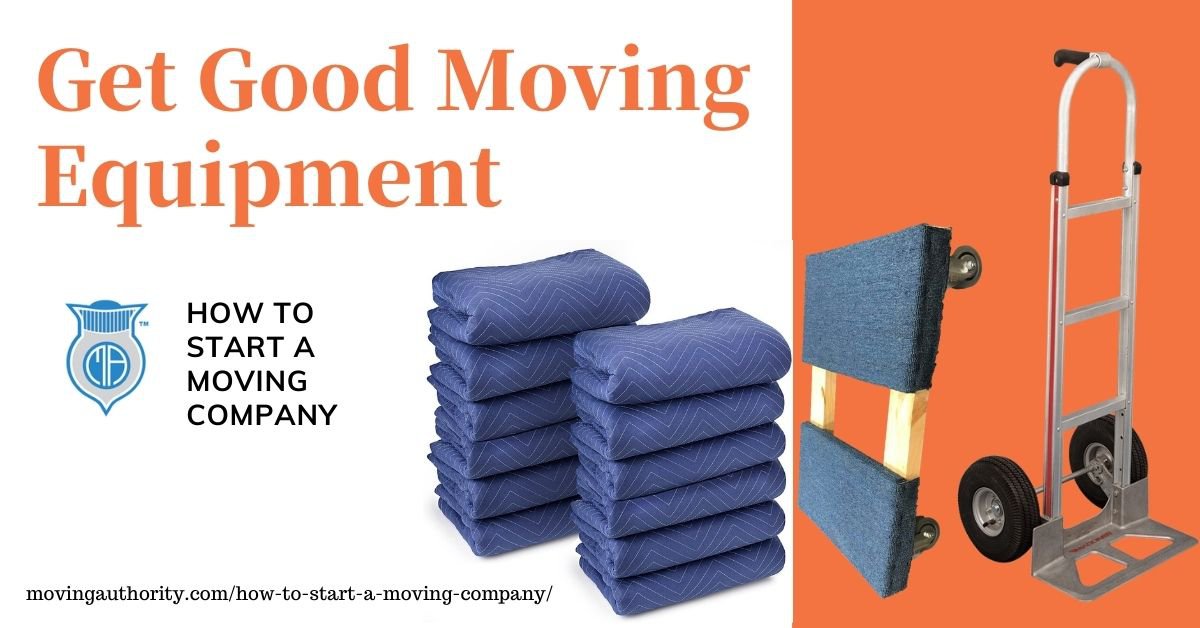How To Start A Moving Company
How to Start A Moving Service
- How to Start a Moving Company
- Step: GET DOT & FMCSA FILING
- Step: MC Number To Get Operating Authority
- Step: "ARBITRATION PROGRAM" is a Must
- Step: "Published Tariff" Service
- Step: Website That Promotes Your Company Well
- Step: Buy Moving Equipment
1. Start a Moving Company Today
So, you want to learn how to start a moving company? This may seem like a straightforward business to start. After all, a business only moves people’s items around, right? Wrong. You're going to have to plan on taking care of many business tasks. That doesn’t only apply to starting your moving business. It takes a lot of hard work to maintain the success of any business. And a moving company is no exception. But do not despair. Moving Authority is here to guide you through every step of starting a new business.
The moving industry is a saturated market. That’s why many companies do not stand the test of time. A business can forget to take key measures. But that’s why our organization is here to help. We’re going to make the business creation process easy for you.
All you've got to do is read our step-by-step guide below. Our mission is to make your new business stand out. You can do so by making high-quality and efficient moves. Make sure to follow this helpful checklist before you start your moving business. It’s best to check off every box before you open your doors for business. Then, you can start getting your customer’s boxes packed and unpacked ASAP.

2. Get DOT & FMCSA Filing & Licensing for Your Business
So you want to know how to start a moving company? This may seem like one of the most straightforward businesses to start, move people's items from A to B. Essentially it is if you are not planning on being around for very long which is never a good mentality when starting a business. The moving industry is a saturated market but many companies don’t last the test of time because they forget to take key measures that we are going to make easy for you by reading our step to step guide below.
Have your company stand out by making a name that is synonymous with quality and efficient moves. Make sure to follow this helpful checklist before you start your moving business to get all your boxes ticked before you get other people's boxes packed, so to speak.
Get a USDOT Number So Your Moving Business Can Start Traveling Over State Lines
Having a USDOT Number is crucial for any new company that performs moving services. The number will allow any worker with a truck to start crossing state lines. There’s no need to research how to get a USDOT Number. Instead, all you've got to do is call our business. We can take care of every federal and state registration need that you have. Sometimes it takes more than one or two filings to start traveling across state lines. But do not despair. Our business can start getting your company registered today. Once you're registered you won’t only operate as a company. Your business will function as an official new moving company. Sure, your new business might start out small. But Moving Authority knows how to make any new business grow fast. And the key is to get a new USDOT Number. Normally done on the (Department of Transportation) website.
Does your moving company have questions about how to get a USDOT Number? If so, please have your moving business contact our own business today. We can help you secure a USDOT Number ASAP. In fact, our experts go through months of registration training. Why? So that they can help every new business succeed. We’re the number one court of business and truck registration. And we’re ready to prove why right now.
Once you’re registered with the right permits, your small business can grow. Speaking of permits, our experts can help you secure any new permits. From standard business permits to permits for taxes and insurance. Our business is the best source of every registration need in the US. And our dedicated moving professionals can start showing you why today.
3.Set Up an MC Number To Get Operating Authority for Your Business
If you're starting a moving business, you need to get a new MC Number. Why? So your moving company can have Operating Authority for interstate moving. That is one of the keys to starting a moving company. If you need an MC Number, don't waste two hours on hold with the DOT. Instead, our business can help you get an MC Number right now. All you've got to do is call us and tell us that you need a new number.
We help every big and small business secure an MC Number. Why? Because having one is crucial when starting a moving company. No moving business can take off without the authority to operate. That’s why our business provides new MC Numbers. But that’s not all. We also help new moving companies secure all other government registration. Our team can even help your business create a custom registration plan. We’ll go registration need by need until your moving business is up and running.
4. Set Up an "Arbitration Program" To Start a Moving Company
It's required by the FMCSA to set up an arbitration program. (FMCSA refers to the Federal Motor Carrier Safety Administration.) You must have an Arbitration service set up before you start a business. This way, you can protect both your company and your future customer base. This refers to any potential problems with your services. Let us know if you’d like to become part of an arbitration program. Moving Authority can set up a custom program on your behalf. This way, your business can settle legal disputes outside of the courts.

Having access to arbitrator matters for any business. An arbitrator is a neutral third party that can help settle disputes. Moving Authority provides arbitrations services to licensed moving companies. We do so on a business-by-business basis across the US. And we can set up an arbitration program without you having to spend much money. An arbitration program is a great tool for growing your business.
5. Using a Published Tariff Service for Your Business
So, what is a published tariff? It’s a menu that sets out all agreed pricing and all line-haul rates for customers. It also sets a valuation option to moving customers. The best suggestion is to get a custom tariff built. In fact, Moving Authority can create any tariff on behalf of your business. We can direct you to our household goods tariff building services.
A tariff must get published before each move takes place. You must have a copy of a published moving tariff in your office. This way, a USDOT officer can access it at your business. Please take note that this process refers to an FMCSA law. The law states that FMCSA officers can inspect tariffs any time that they request. Do not get a tariff from an unauthorized moving tariff company. Instead, our business professionals will take care of your tariffs. If there is an issue with the USDOT, the carrier is responsible. So, never cut the costs on your tariffs. And never have your business confuse moving software as a tariff.

6. Secure Insurance for Your Business, Company, or Franchise
Make sure to get cargo and basic liability insurance for your business. Also, try to get workman’s comp insurance. Why? Because your workers will take part in moving and hauling large items. This means there’s a possibility that your workers can get injured. That’s why it’s best to protect yourself and your business by staying prepared. The next key action is to secure a custom-published moving tariff.
Do you have questions about which insurance your new moving company needs? If so, we can help you get the right insurance today. That’s one of the key actions when anyone’s starting out as a business owner. Insurance is a crucial need. And Moving Authority is here to go need by need for you and your business.
Make a Business Website That Promotes Your Company or Franchise
It’s now time to get a website made. Most (if not all) of your sales will come from online searches. That’s how people will find the movers at your business. So, get online today. Make sure you have a catchy and unique logo. Also, make your website user-friendly and mobile-friendly.
Doing both will help drive up sales at your business. Another helpful hint is to add your business to Google Places. Why? So your business is better linked and will show up in local customer searches. You could even have your business listed on Moving Authority. Then, you can link back to the profile page of your business. You could make a posting of different business awards and accreditations. This will show how high-quality your moving company is. It will also show that your moving company does great work.
As a mover, you want your business to become known in the industry. Having a quality website is another key component of growing a moving company. Your business goal should focus on having one of the top sites in the moving industry. Marketing is a crucial aspect of a moving company succeeding. In fact, these days, no moving company can make money without quality marketing. But marketing is about more than only making money. It’s about feeling free to showcase your services, big and small.
If you need help with marketing, please contact our business today. We can help you create a new marketing plan for your moving company. Marketing is one of the key areas to focus on when you start a moving company or LLC. But you need to do it right. And that’s why our experts are here to help you start doing so today. Marketing will offer a window into the services of your new moving company. Think of it as insurance for how to grow the services of your business.
7. Buy Moving Equipment for Your Business
It’s time for your business to invest in real equipment. Besides your truck or trucks, you need the following services:
-Boxes, a dolly, and other moving equipment
-An appliance dolly for refrigerators or appliances
-Quilts/blankets to wrap furniture
-A four-wheeler dolly for large items
It is best for the long haul of your business to invest in professional-grade equipment. Your business should not rely on items from stores like Home Depot. Sure, those tools will work well for your business. But they cannot withstand wear and tear over the years. That’s why proper equipment is better. It doesn’t tend to break as fast for any business in the moving industry.
Take Care of Legal Expenses So Your Business Can Operate in a Legal Manner
Companies like Moving Authority have changed the online game for every business. We help businesses after businesses gets licensed and accredited. Then, they have the ability to meet customers’ needs and budgets. Make sure that your business gets listed on our website and others. That is a key step to success. Do you want to learn more about starting your own moving company? If so, we recommend that you view the video above. It will give you a rundown on what your business needs to operate in a legal manner. This way, you can operate across state lines while adhering to FMCSA regulations.
Moving Authority Makes Starting a Moving Business Simple & Easy
Our experts know all about what setting up a new moving company involves. There aren’t one or two services to create. Instead, a new business has to provide dozens of services at the same time. But do not get stressed about having to deal with business need after need. We can help you plan for success using our top-rated business services. All you've got to do is contact us through the phone or our website. You can let us know what services your business is trying to set up. We won’t take a month or two to respond. And we won’t demand money or try to sell you on an offer. Instead, our business will get back to you in record time.
We can help you create a new business plan to make your moving company grow. There are no limits to the services that we can provide to any moving company. Other companies use standard services that only go through the motions. But that’s not how we do business. We make our business services customized for every business. This applies to both a new or small business starting out and even a large franchise. Our mission is to go business need by need and improve every moving company. And we have the resources to start doing so today.
Contact Us Today About Starting a Moving Company- We’ll Reply ASAP
Links Related To Moving Companies and Movers
How Much Can You Earn From a Moving Company?
Average earnings that a moving company will make vary based on many factors. A new moving company might only start off with a profit of around 10 percent. If this happens to you or the profit margin’s less, do not despair. It takes time to figure out how to earn a lot of money in the moving industry. Many moving startups will only have a 5 or 6 percent profit margin at first. Say that you work hard and get many moving jobs in a year or so. Your profit reach could exceed 20 percent.
Revenue per month comes down to how much time your team moves furniture. An average small mover charges $50 to $200 to move each furniture item. Exact profits for jobs depend on the size of a move and the miles traveled. Let’s say that you start out operating only 10 to 20 hours per week as a mover. This could bring in well over $1,000 per month on a part-time basis. Then, as your company grows, you can begin to make more money each month.
What Happens If a Moving Truck Is in an Accident?
Accidents in moving trucks often take place due to the size of the trucks. After all, a moving truck is so much bigger than a standard vehicle. That's why you must train your drivers to drive with caution. The key is to drive a truck while focusing on defensive driving. This means increasing stopping distance at all times. Plus, a moving truck operator has to stay aware of overhead clearance. Despite steps like these, sometimes accidents happen.
Say that you're a moving truck driver and you get into an accident. Do not panic. First, get everyone out of the truck. If you can, move your truck off the roadway. Try to park the moving truck in a parking lot or on the shoulder of the road. If an injury’s taken place, call an ambulance. Next, call the local police so that you can file an accident report. Do not forget to write down the information of the other parties. After the police create a report, you can call your insurance company. The company will then guide you through a series of steps.
How Do Moving Companies Work?
Every moving company cannot become successful until it focuses on calculating costs. This process starts by sending over a relocation specialist to a home or business. The specialist will conduct a visual survey. The survey will assess key factors related to the upcoming move. One of those factors is the estimated weight of the goods that will get moved. Then, your moving company should ask if it can pack the goods for the customer. If so, make sure your business has professionals who know how to pack all sorts of items. Also, check to see if there are any physical problem-areas at the home/business. These include narrow hallways and long flights of stairs.
Let’s say that you're operating as an interstate (long distance) mover. You will charge customers based on the following three factors. The first factor is the exact weight of the shipment that will get moved. Next, you must calculate the move distance (mileage) to the new home or business. The third factor comes down to the extra services that your company can provide. These include packing items, assembling furniture, and placing goods in storage.
Now, let’s say that you're operating as a local mover instead of an interstate mover. Almost all local movers charge customers on a per-hour basis. The cost also depends on how many movers work on one moving job. Many local and interstate movers provide free moving estimates to customers. You can take care of the estimate through an official document. Moving companies provide the document after the visual survey process. The quote can also feature other potential services that your company can provide. This way, a customer can make an informed buying decision right away.
What Type of Moving Business Should You Start?
It’s time to plan your moving company to meet your exact expectations. It’s up to you whether you want to start a business that performs local moves. Or, you might instead want to form an interstate moving company. Either way, here are some steps to keep in mind as you start your business. One of the first steps is to form your company as a legal entity. Then, you can register the moving company to pay taxes. Do not forget to open a business bank account and get a credit card for the company. This way, you can set up accounting processes within the moving business.
There are licenses and permits that your new moving company must secure. Say that you're forming an interstate moving business. This means you will need to get a USDOT number through the FMCSA. Then, you must secure quality moving company insurance. As you take these steps, consider defining your moving company brand. After all, what will make your company stand out from your competitors? Once you have a solid idea, you can create a moving company website.
Let’s say that you're forming your moving company as a legal entity right now. Have you considered starting a limited liability company? Having an LLC can protect your personal assets as a business owner. No matter what type of entity you select, your company must also secure an EIN. Without an EIN, a business cannot hire employees or open a bank account. Then, your startup can hire people to operate your moving truck. Also, do not forget to buy equipment for your new business. The cost of equipment can vary depending on your unique company goal. No matter what, Moving Authority is here for you and your new business. Businesses in every state depend on our services to build their startups. They know that our employees go the extra mile to create lasting success.
What License Do I Need To Start a Moving Company?
Every moving company with large trucks must have the right licensing at all times. There is separate licensing for an interstate or intrastate moving company. Both types of companies need to have proper permits, licenses, and registration. A moving company license must meet all DOT standards. The DOT refers to the United States Department of Transportation. Also, are you familiar with the FMCSA? It is the Federal Motor Carrier Safety Administration. A moving company must adhere to all DOT and FMCSA licensing standards.
It is crucial for almost every moving company to get a US DOT number. Why? Because moving trucks are big. Large-sized commercial vehicles have to use DOT numbers to operate. Without a number, a moving company cannot take part in interstate commerce. This FMCSA rule applies to any vehicle that weighs over 10,001 pounds. A moving business can secure a DOT number through the Unified Registration System. You can access URS via the official FMCSA website.
Many moving companies also need to secure an MC number. The number will provide a truck driver with official FMCSA operating authority. Without the number, most US moving companies cannot transport cargo. Keep in mind that Moving Authority can get your company registered. We provide full-scale MC and DOT number registration services. All you've got to do is give us a call. Then, our experts can get your moving company registered with the DOT and FMCSA. In fact, we can guide your business through the entire FMCSA application process.
Are You a Transport Company?
No. Moving Authority operates on behalf of moving companies across the US. Our business plan focuses on keeping each company in compliance with the government. Do you plan to own a successful moving business? If so, starting out involves a lot of paperwork to register with the FMCSA. It can feel like a new moving company needs permit after permit to operate. But that’s where we step in. We have a business structure that focuses on keeping businesses in complete compliance. This way, you won't have to lose income toward paying government fines.
If you intend to own a successful moving company, please contact us at any time. Our mission is to help your small business thrive in the moving industry. Sure, you must deal with many overhead expenses like marketing and cargo insurance. But Moving Authority can help you become successful and profitable. In fact, our success is your success.
We’ve helped thousands of moving businesses rise above their competitors. Our team’s standing by to do the same for your own moving brand. Please give us a call if you're interested in growing your business fast. Now, there's no such thing as the perfect moving company. But our experts can help position your startup for a future of success. We’re standing by right now to focus on helping you grow your business.
How Can We Help?
The Moving Authority team’s prepared to help your company secure the right licensing. Every employee in our organization knows all about running a moving brand. Whether you're an S Corp or standard Corp, we’re here to help you succeed. Our organization’s assisted smaller moving companies for over a decade. Each time, we focus on every market aspect of moving. From how to set your revenue goals to how to secure more customers. We can also provide information about liability insurance and other start up costs.
You see, moving is about more than transporting cargo and moving blankets. It’s about dominating your target market without even needing many investors. Through our services, we can help any entrepreneur when starting a new business. You cannot afford to depend on word of mouth to get people interested. Instead, your moving services cannot appear the same as any other company’s. So, please call us right now for help with any aspect of operating your own business. We cannot wait to help you take your new moving company to new heights.
Do You Have a Question?
Say that you have a question about how to start a new moving company. Do not hesitate to give our business a phone call. If we cannot answer, one of our experts will return your call ASAP. Plus, we also encourage you to browse the services section of our website. You'll find that Moving Authority is unlike any other moving association. We have the tools and resources for your new company to become a powerhouse. Our moving registration experts cannot wait to help you succeed.



Add Comment